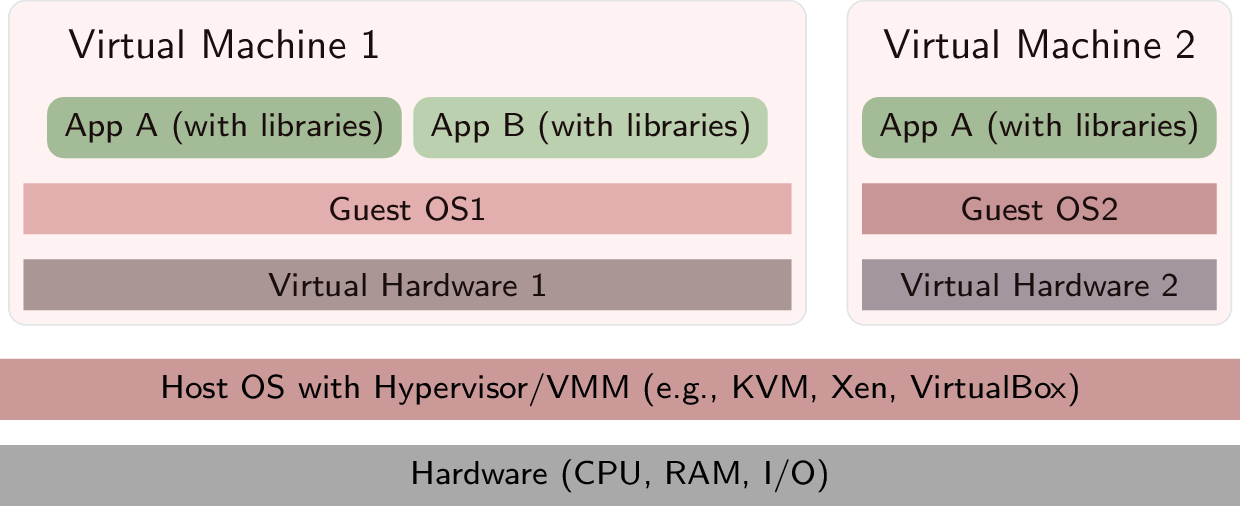Virtualization
(Usage hints for this presentation)
IT Systems, Summer Term 2025
Dr. Jens Lechtenbörger (License Information)
1. Introduction
1.1. Core Questions
- What do virtualization and containerization mean?
- How to deploy potentially complex software in a reproducible fashion?
1.2. Learning Objectives
- Explain definitions of virtual machine and virtual machine monitor
- Explain and contrast virtualization and containerization
- Including isolation
- Including layering
- Use Docker for simple tasks
- E.g., start web server with static files
- Interpret simple Docker files
1.3. Overview (1/2)
Virtualization provides (virtual) hardware interface
![Layering with virtualization]()
Interface implemented by Hypervisor/VMM
- VMM runs on (usual) host OS, manages real hardware
Virtual hardware can have arbitrary features
- Largely independent of real hardware, say, ten network cards
- On top of virtual hardware, install operating systems (guests) and other software to create virtual machines (VMs)
- Share resources of powerful server machine among
several VMs
- E.g., your “own” server as VM in a project seminar
- Fire up lots of identical VMs for compute-intensive tasks with cloud computing
1.4. Overview (2/2)
Containerization (e.g., with Docker) as lightweight variant of virtualization
![Layering with containerization]()
- Containerization provides OS interface
- No virtual hardware, but shared OS kernel
Use containers to execute software (versions) in controlled way
- Think of larger application that uses external libraries
- Libraries evolve, may introduce incompatible changes over time
- Specific version of application depends on specific versions of libraries
- Container bundles “correct” versions
Agenda
2. History and Variants
2.1. History (1/2)
- Virtualization is an old concept
- IBM mainframes, 1960s
- Frequently cited survey article: (Goldberg 1974)
- Original motivation
- Resources of expensive mainframes better utilized with multiple VMs
- Ability to run different OS versions in parallel, backwards compatibility, incremental updates
- 1980s, 1990s
- Multitasking OSs on relatively cheap hardware
- Early PC hardware did not offer virtualization support
- Little use of virtualization
- Multitasking OSs on relatively cheap hardware
2.2. History (2/2)
- Ca. 2005
- PC success becomes problematic
- How to limit energy usage and management overhead of fleets of PCs?
- One answer: Use virtualization for server consolidation
- Turn independent servers into VMs, then allocate them to single server
- Servers often with low resource utilization (e.g., CPU usage between 10% and 50% at Google in 2007, (Barroso and Hölzle 2007))
- Consolidated server with improved resource utilization
- Additional answer: Virtualization reduces management, testing, and deployment overhead, see (Vogels 2008) for Amazon
- Virtualization as enabler for cloud computing
- PC success becomes problematic
- Literature
- (Soltesz et al. 2007): Containers for lightweight virtualization
- (Castro et al. 2019; Kounev et al. 2023): Serverless computing
2.3. Virtualization Variants
Virtualization: Creation of virtual/abstract version of something
- Hardware/system: virtual machine (VM)
- Virtual memory in OSs
- Network, e.g.,
overlay networks,
software-defined networking
- Beyond class
- Execution environment (e.g., Java, Dotnet)
- Typical meaning: virtual machine (VM)
- Virtual hardware
- Several OSs run concurrently, share (variants of) underlying hardware
- VMs isolated from each other
- Virtual hardware
3. Virtualization
3.1. Definitions
Cited from (Popek and Goldberg 1974)
“A virtual machine is taken to be an efficient, isolated duplicate of the real machine.” (bold face added)
Made precise with Virtual Machine Monitor (VMM)
“First, the VMM provides an environment for programs which is essentially identical with the original machine; second, programs run in this environment show at worst only minor decreases in speed; and last, the VMM is in complete control of system resources.”
Essentially identical: Programs with same results (as long as they do not ask for hardware specifics), maybe different timing
Speed: Most instructions executed directly by CPU with no VMM intervention
Control: (1) Virtualized programs restricted to resources allocated by VMM, (2) VMM can regain control over allocated resources
“A virtual machine is the environment created by the virtual machine monitor.”
3.2. Isolation
Isolation of VMs: Illusion of exclusive hardware use (despite sharing between VMs)
- Related to “isolated duplicate” and “complete control” of (Popek and Goldberg 1974)
Sub-types (see (Soltesz et al. 2007; Felter et al. 2015))
Resource isolation: Fair allocation and scheduling
- Reservation (e.g., number of CPU cores and amount of RAM) vs best-effort
Fault isolation: Buggy component should not affect others
Security isolation
- Configuration independence (global names/settings do not conflict)
- Safety (no access between VMs/containers)
- Beware! Lots of security issues in practice
3.3. Layering with Virtualization
Hypervisor/VMM with full access to hardware
![Layering with virtualization]()
- Most privileged code
- Recall CPU Rings
- Creates abstract versions of hardware, to be used by de-privileged guest OSs
- Most privileged code
- Notes
- Each VM can run different OS, isolated from others
- VM backups/snaphots simplify management, placement, parallelization
- Creation of more VMs with high overhead
- (Compared to containerization)
- Each VM can run different OS, isolated from others
3.4. Self-Study Question
- The Java VM was mentioned as variant of virtualization. Discuss whether it satisfies the conditions for virtualization as defined in 1974.
Bibliography
License Information
Source files are available on GitLab (check out embedded submodules) under free licenses. Icons of custom controls are by @fontawesome, released under CC BY 4.0.
Except where otherwise noted, the work “Virtualization”, © 2019, 2021, 2024-2025 Jens Lechtenbörger, is published under the Creative Commons license CC BY-SA 4.0.


